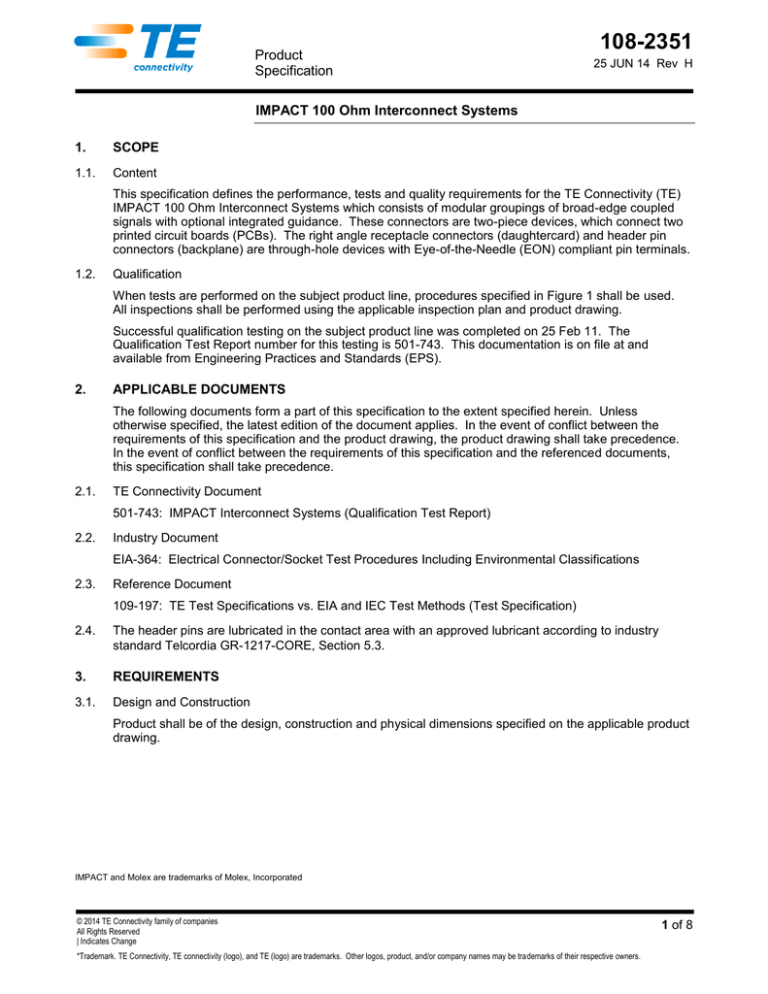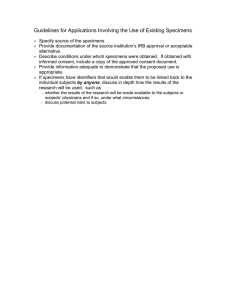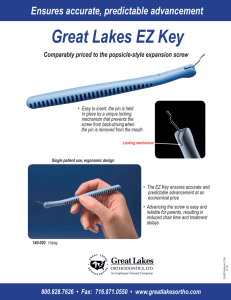
Product
Specification
108-2351
25 JUN 14 Rev H
IMPACT 100 Ohm Interconnect Systems
1.
SCOPE
1.1.
Content
This specification defines the performance, tests and quality requirements for the TE Connectivity (TE)
IMPACT 100 Ohm Interconnect Systems which consists of modular groupings of broad-edge coupled
signals with optional integrated guidance. These connectors are two-piece devices, which connect two
printed circuit boards (PCBs). The right angle receptacle connectors (daughtercard) and header pin
connectors (backplane) are through-hole devices with Eye-of-the-Needle (EON) compliant pin terminals.
1.2.
Qualification
When tests are performed on the subject product line, procedures specified in Figure 1 shall be used.
All inspections shall be performed using the applicable inspection plan and product drawing.
Successful qualification testing on the subject product line was completed on 25 Feb 11. The
Qualification Test Report number for this testing is 501-743. This documentation is on file at and
available from Engineering Practices and Standards (EPS).
2.
APPLICABLE DOCUMENTS
The following documents form a part of this specification to the extent specified herein. Unless
otherwise specified, the latest edition of the document applies. In the event of conflict between the
requirements of this specification and the product drawing, the product drawing shall take precedence.
In the event of conflict between the requirements of this specification and the referenced documents,
this specification shall take precedence.
2.1.
TE Connectivity Document
501-743: IMPACT Interconnect Systems (Qualification Test Report)
2.2.
Industry Document
EIA-364: Electrical Connector/Socket Test Procedures Including Environmental Classifications
2.3.
Reference Document
109-197: TE Test Specifications vs. EIA and IEC Test Methods (Test Specification)
2.4.
The header pins are lubricated in the contact area with an approved lubricant according to industry
standard Telcordia GR-1217-CORE, Section 5.3.
3.
REQUIREMENTS
3.1.
Design and Construction
Product shall be of the design, construction and physical dimensions specified on the applicable product
drawing.
IMPACT and Molex are trademarks of Molex, Incorporated
© 2014 TE Connectivity family of companies
All Rights Reserved
| Indicates Change
*Trademark. TE Connectivity, TE connectivity (logo), and TE (logo) are trademarks. Other logos, product, and/or company names may be trademarks of their respective owners.
1 of 8
108-2351
3.2.
Materials
Materials used in the construction of this product shall be as specified on the applicable product
drawing.
3.3.
Ratings
3.4.
Agency Voltage:
29.9 volts AC, rms DC maximum
Non-Agency Voltage:
150 volts AC, rms DC maximum
Current:
0.75 ampere maximum per contact
Temperature: -55 to 85°C
Performance and Test Description
Product is designed to meet the electrical, mechanical and environmental performance requirements
specified in Figure 1. Unless otherwise specified, all tests shall be performed at ambient environmental
conditions.
3.5.
Test Requirements and Procedures Summary
Test Description
Requirement
Procedure
Initial examination of product
Meets requirements of product drawing.
EIA-364-18.
Visual and dimensional (C of C)
inspection per product drawing.
Final examination of product
Meets visual requirements.
EIA-364-18.
Visual inspection.
ELECTRICAL
Low Level Contact Resistance
(LLCR)
∆R 10 milliohms maximum.
Refer to Figure 5 for typical initial bulk
resistances.
EIA-364-23.
Subject specimens to 100
milliamperes maximum and 20
millivolts maximum open circuit
voltage. See Figure 3.
Insulation resistance.
1000 megohms minimum.
EIA-364-21.
500 volts DC, 2 minutes hold. Test
between adjacent contacts of
unmated specimens.
Withstanding voltage.
One minute hold with no breakdown,
flashover or leakage exceeding 5
milliamperes
EIA-364-20, Condition 1.
500 volts AC at sea level. Test
between adjacent contacts of
unmated specimens.
Compliant pin interface
resistance.
One million maximum
EIA-364-23.
Subject specimens to 100
milliamperes maximum and 20
millivolts maximum open circuit
voltage. Contact inserted into PCB.
MECHANICAL
Sinusoidal vibration.
No discontinuities of 10 nanoseconds or
longer duration. See Note.
EIA-364-28.
Subject mated specimens to 10 to
500 to 10 Hz traversed in 1 minute
with 1.5mm maximum total
excursion or 10 G peak. Three
hours in each of 3 mutually
perpendicular planes. See Figure 4.
Figure 1 (cont)
Rev H
2 of 8
108-2351
Test Description
Requirement
Procedure
Mechanical shock.
No discontinuities of 10 nanoseconds
or longer duration. See Note.
EIA-364-27, Condition H.
Subject mated specimens to 30 G’s
half-sine shock pulses of 11 seconds
duration. Three shocks in each
direction applied along 3 mutually
perpendicular planes, 18 total shocks.
See Figure 4.
Durability
See Note.
EIA-364-9.
Mate and unmate specimens for the
numbers of cycles specified in Figure 2
at a maximum rate of 500 cycles per
hour.
Mating force.
35 grams maximum (average per
pin, over entire assembly)
EIA-364-13.
Measure force necessary to mate
daughtercard and backplane at a
maximum rate of 25.4mm per minute.
Unmating force.
15 grams minimum, Initial 8 grams
minimum, End of Life (average per
pin, over entire assembly)
EIA-364-13.
Measure force necessary to unmate
daughtercard and backplane at a
maximum rate of 25.4mm per minute.
Compliant pin insertion force.
26.7 N maximum for headers.
17.8 N maximum for receptacles
These max values are intended for
press sizing only. The peak force
value will occur prior to the final
seating of the connector. Plating
surface finish and PCB materials will
impact actual values.
EIA-364-5.
Measure force required to insert a
contact into the PCB at a maximum
rate 5.08mm per minute.
Compliant pin retention force.
3.6 N minimum for both headers and
receptacles. Data reflects minimum
average values for retention forces
when tested in plated through holes
drilled and plated as described in the
appropriate impact application
specification. Plating surface finish
and PCB materials will impact actual
values.
Radial hole deformation: 1.5 mils
maximum
Axial hole deformation: 1.0 mil
maximum
EIA-364-5.
Measure force required to remove a
contact from the PCB at a maximum
rate 5.08mm per minute.
Minute/thermal disturbance.
See Note.
EIA-364-110. (Thermal Cycling),
condition A, Duration A. Subject
mated specimens to 10 cycles
between 15 and 85°C. Dwell until
acclimated, transition approximately 10
degrees per minute.
Figure 1 (cont)
Rev H
3 of 8
108-2351
Test Description
Requirement
Procedure
ENVIRONMENTAL
Thermal shock
See Note.
EIA-364-32, Test Condition I. Subject
mated specimens to 5 cycles between
-55 and 85°C with 30 minute dwells at
temperature extremes and 1 minute
transition between temperatures.
Humidity/temperature cycling.
See Note.
EIA-364-31, Method III.
Subject mated specimens to 500 hours
between 25 and 65°C at 80 to 100%
RH.
Temperature life.
See Note.
EIA-364-17, Method A, Test Condition
3, Test Time Condition C. Subject
mated specimens to 85°C for 500
hours.
Mixed flowing gas.
See Note.
EIA-364-65,Class IIA (4gas). Subject
specimens to environmental Class IIA
for 20 days (10 days unmated,
followed by 10 days mated). Measure
LLCR every 5 days.
Dust.
See Note.
EIA-364-91.
Subject unmated specimens to #1
(benign) dust for 1 hour.
Specimens shall not be removed
from the chamber for a minimum of
1 hour after completion of the test.
NOTE
Shall meet visual requirements, show no physical damage, and meet requirements of additional
tests as specified in the Product Qualification and Requalification Test Sequence shown in
Figure 2.
Figure 1 (end)
Rev H
4 of 8
108-2351
3.6.
Product Qualification and Requalification Test Sequence
Test Group (a)
Test or Examination
1
2
3
4
5
6
7
1
1
Test Sequence (e)
Initial Examination of Product
LLCR
2
1
1
1
1
4,6
3,5
2,5,7,9
2,4,7,9,11
2,4,6,8,10,12,14,16,18
Insulation Resistance
2,6
Withstanding voltage
3,7
Compliant pin interface resistance
3,6
Sinusoidal vibration
6
Mechanical shock
8
Durability
3(f),8(f)
Mating force
3,8
2,7
Unmating force
7
6
Compliant pin insertion force
1
3(f),10(f)
5(g),17(g)
2,5(d)
Compliant pin retention force
4,7
Minute/thermal disturbance
15
Thermal shock
4
Humidity/temperature cycling
Temperature life
4
6
5
5
3(i)
Mixed flowing gas
7,9,11,13
Dust
Final examination of product
9
8
4
5
10
12
19
8
8(h)
NOTE
a. See Paragraph 4.1.A.
b. Separate specimens must be run for LLCR and discontinuity monitoring.
c. This test group not mounted on PCB’s.
d. Remove and replace specimens on PCB 1 time.
e. Numbers indicate sequence in which tests are performed.
f. 100 cycles only.
g. 98 cycles only.
h. Cross section compliant pin joints (initial and reworked connectors).
i. 300 HOURS.
Figure 2
Rev H
5 of 8
108-2351
4.
QUALITY ASSURANCE PROVISIONS
4.1.
Qualification Testing
A.
Specimen Selection
Specimens shall be prepared in accordance with applicable instruction sheets and shall be
selected at random from current production. Test groups 1, 2, 3, 4, 6 and 7 shall each consist of 5
mated pairs. Test group 5 shall consist of 10 mated pairs.
B.
Test Sequence
Qualification inspection shall be verified by testing specimens as specified in Figure 2.
4.2.
Requalification Testing
If changes significantly affecting form, fit or function are made to the product or manufacturing process,
product assurance shall coordinate requalification testing, consisting of all or part of the original testing
sequence as determined by development/product, quality and reliability engineering.
4.3.
Acceptance
Acceptance is based on verification that the product meets the requirements of Figure 1. Failures
attributed to equipment, test setup or operator deficiencies shall not disqualify the product. If product
failure occurs, corrective action shall be taken and specimens resubmitted for qualification. Testing to
confirm corrective action is required before resubmittal.
4.4.
Quality Conformance Inspection
The applicable quality inspection plan shall specify the sampling acceptable quality level to be used.
Dimensional and functional requirements shall be in accordance with the applicable product drawing and
this specification.
Figure 3
LLRC Measurement Points
Rev H
6 of 8
108-2351
Figure 4
Vibration and Mechanical Shock Mounting Fixture
Left Waflet
Right Waflet
Row
Electrical Lengths
[mm]
Bulk Resistance
[mΩ]
Electrical Lengths
[mm]
Bulk Resistance
[mΩ]
A
GND
6.9
16.4
10.5
B
19.0
11.9
17.9
11.6
C
19.9
12.5
GND
7.5
D
GND
8.3
21.6
13.1
E
25.2
13.9
23.4
13.7
F
26.0
14.9
GND
8.9
G
GND
8.6
27.7
16.9
H
31.4
16.5
29.5
17.1
J
32.0
17.6
GND
11.0
K
GND
10.5
33.8
19.7
L
37.4
19.0
35.6
19.7
M
38.1
19.1
GND
11.1
N
GND
10.4
40.0
21.3
O
43.6
20.9
41.8
21.7
P
44.4
21.8
GND
11.3
R
GND
11.0
46.1
22.7
S
49.9
23.1
47.9
24.0
T
50.6
22.4
GND
13.7
NOTE
1. Electrical lengths are measured from receptacle compliant pin to header compliant pin.
2. The chart represents values for conventional right angle receptacles to vertical headers.
Figure 5
Signal Contact Typical Initial Bulk Resistances
Rev H
7 of 8
108-2351
Product Type
Screw Type
Board Thickness
Recommended Torque
Backplane Headers
2P through 6P
2-56 Machine Screw
6.5 mm max
2.0 in-lbs
Daughtercard
Receptacles 2P
2-32 Self-Tapping Screw
1.8 to 2.4 mm
1.0 in-lbs
Daughtercard
Receptacles Standard 3P
2-32 Self-Tapping Screw
1.9 to 2.5 mm
1.5 in-lbs
Daughtercard
Receptacles Ortho 3P
2-32 Self-Tapping Screw
2.4 mm max
1.0 in-lbs
Daughtercard
Receptacles
4P through 6P
2-32 Self-Tapping Screw
4.4 mm max
2.0 in-lbs
Mezzanine
Receptacles
3P through 5P
2-32 Self-Tapping Screw
4.4 mm max
2.0 in-lbs
Ram Headers 2P
2-32 Self-Tapping Screw
4.0 mm max
1.0 in-lbs
Ram Headers 3P
2-32 Self-Tapping Screw
4.4 mm max
1.5 in-lbs
Ram Headers
4P through 6P
2-32 Self-Tapping Screw
4.4 mm max
2.0 in-lbs
NOTE
The thread forming screws used for the Daughtercard guidance modules will require varying
torque to seat the screw, dependent upon the screw engagement in the module. The screw
length and the PCB thickness will both impact the screw engagement into the module. It is
recommended that the torque applied be the minimum necessary to fully seat the screw for the
specific application. For applications in which the board thickness exceeds the listed
recommendations, testing should be conducted to confirm that 1.0 in-lbs of torque can
successfully be applied.
Figure 6
Torque Specifications for Mounting Screws
Rev H
8 of 8





